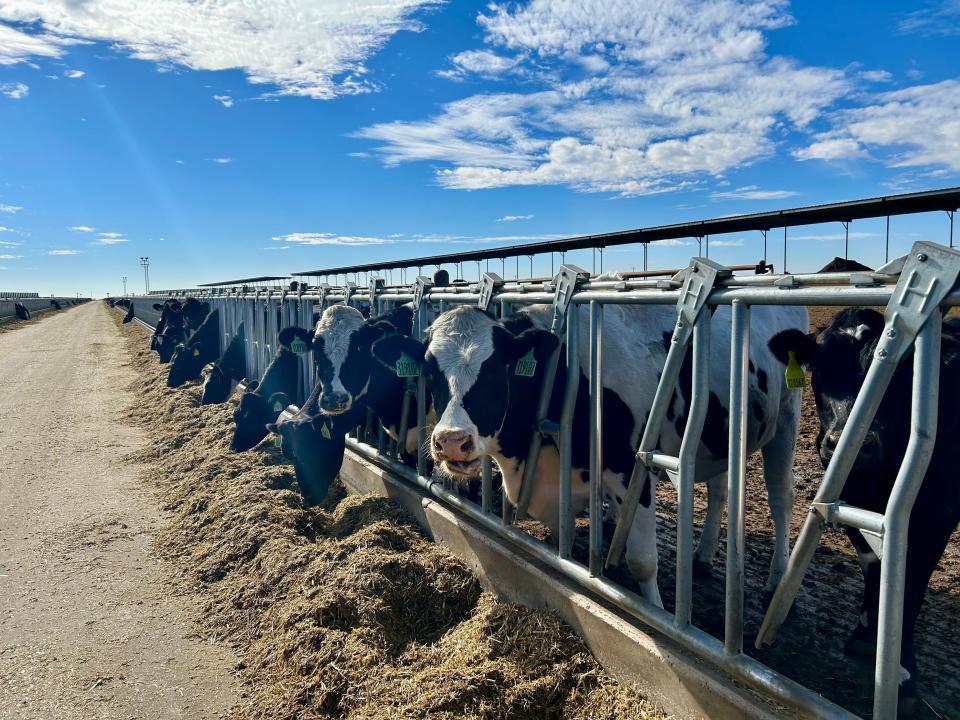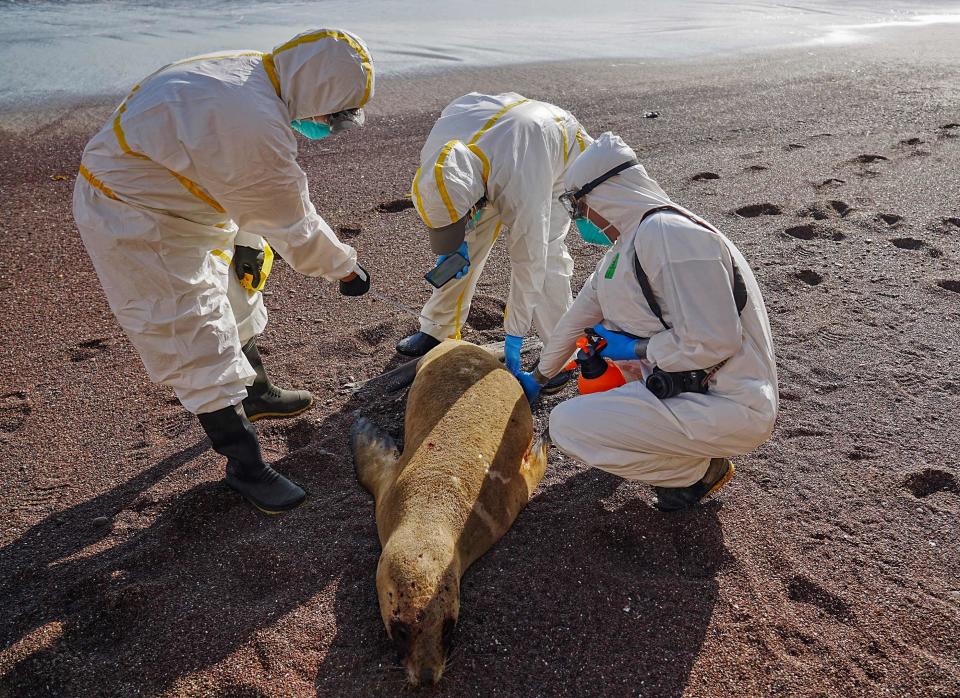Bird flu outbreak is an 'evolving situation.' Here's what to know about symptoms, spread.
Many Americans are brimming with questions after officials in Texas last week announced the state's first case of bird flu in a human.
On April 1, Texas health officials said a person became infected with bird flu, or avian influenza A(H5N1) virus, after close contact with infected cows. The week prior, sick dairy cattle in Texas and Kansas tested positive for bird flu. Bird flu was later reported in a Michigan dairy herd that included cows transported from Texas. Cattle in New Mexico and Idaho are also presumed to be positive for the disease, officials said.
The only symptom reported by the Texas patient was pink eye, or conjunctivitis, according to an update April 1 from the U.S. Centers for Disease Control and Prevention.
Officials say the risk to public health remains low. They note that there are steps people can take to curb the spread of the potentially dangerous virus. The events in Texas, they say, raise future concerns about how the bird flu virus evolves.
"This is definitely an evolving situation," Dr. Diego Diel, director of Cornell University's virology laboratory at the Animal Health Diagnostic Center, which worked to sequence the virus, told USA TODAY. "Right now, I think the viruses that have been detected in cattle and in other animals in these farms don't contain any mutations that would indicate increased transmissibility or pathogenesis to humans."
But if the virus is being transmitted from cow to cow, Diel stressed, it's important to continue monitoring the virus in the long term to see whether there are potential mutations that could cause spillover into other species, including humans.
CDC says cases rising: What to know about meningococcal disease

How does bird flu spread?
Bird flu primarily spreads through contact with infected birds. Most cases in humans have occurred after a person had unprotected exposure to sick or dead infected animals.
Avian flu viruses infect birds’ respiratory and gastrointestinal tracts, which causes them to shed the virus via their saliva, mucous and feces, the CDC said. Humans and other mammals can get it when they get enough virus in their eyes, nose, or mouth or inhale it into their lungs.
People who have close contact or unprotected contact for long periods are at greater risk of infection. The disease can cause mild upper respiratory issues or severe illness, including pneumonia and multiple organ failure that leads to death.
In the U.S., the disease tends to spread from wild birds. However, outbreaks in commercial poultry or backyard flocks that led to deaths have been reported in 48 states since February 2022.
Can cats get bird flu?
Officials identified the latest bird flu cases in unpasteurized milk from sick cattle at dairy farms in Kansas and Texas, in addition to a positive throat swab of a cow at another Texas dairy farm. This spread to cows is believed to be the first for the species. The other species caught the virus directly from wild birds: cats.
Cornell researchers believe the virus was transmitted to Texas dairy cows through contaminated water and other food sources from infected birds migrating through the area. The virus then likely spread among cows who were near each other or the birds, however, there isn't yet definitive proof of this, said Diel, who is an associate professor of virology.
In early March, Dr. Elisha Frye, an assistant professor of practice at Cornell's Department of Population Medicine and Diagnostic Sciences, received a call about an outbreak among Texas dairy herds of a disease of unknown origin. Samples of milk and manure and nasal swabs from the cattle showed bird flu was present. Researchers also found evidence of bird flu in the testing of dead birds and one of three cats found dead at the dairy facilities around the same time.
"It was kind of the same timeline as when we found it in the cattle samples, but it did kind of link it together," Frye told USA TODAY. "The birds, the cat and milk from the cows all having the same pathogen in them made sense at the time for that being the main cause of illness."
How do humans get bird flu?
It's rare for humans to be infected with bird flu. The only other human case in the U.S. occurred in 2022, in a person incarcerated in a Colorado prison who was exposed to poultry infected with avian flu.
On Tuesday, the CDC said the current public health risk is low, and there is no person-to-person spread of bird flu so far. That is a vital measurement that would prompt concern for the spread of the disease.
There remains an increased risk for poultry, livestock and farmers and workers in these sectors, as well as veterinarians, veterinary staff and first responders who respond to cases, officials said.
Ozempic and Wegovy: Weight-loss drugs cost $1,000 a month but less than $25 to make. Why do we pay so much?

Do eggs carry bird flu? What about dairy products?
Food production officials have been taking steps to prevent the distribution of milk or eggs from infected animals. Cooked eggs and pasteurized milk, in general, should be safe for consumers.
Last week, the largest U.S. chicken egg supplier reported positive tests for bird flu at its facility in the Texas Panhandle. In a news release, Cal-Maine Foods said production at the Panhandle facility stopped temporarily, following protocols to prevent bird flu set by the U.S. Department of Agriculture. Personnel at the company killed about 1.6 million laying hens and 337,000 young hens to curb the spread of the virus.
There isn't as simple of a solution to reduce the risk of bird flu since the eggs can carry the virus, so the traditional method has been to destroy products and kill the poultry, said Diel, of Cornell.
Among dairy cows, milk from animals suspected or confirmed to have the virus is being removed from human food supplies. However, even if milk from infected cows makes it to the commercial milk supply, pasteurization effectively inactivates bacteria and viruses, including influenza, according to a March 29 joint news release from the CDC, USDA and the Food and Drug Administration. In addition to protecting against bird flu, pasteurization is central to other health efforts. The FDA says that unpasteurized raw milk can have microorganisms dangerous to human health.
Dr. Meghan Davis, an associate professor at the Johns Hopkins Bloomberg School of Public Health and a former dairy veterinarian, said it’s important to note differences among industries in poultry and cattle, and how the virus gets treated: Chicken culling, or killing, has been a steadfast way to curb disease spread, whereas this is a first for cattle, and it appears cows aren’t getting as sick.
She said people are at risk if they consume raw milk and cheese or live near an area with intensive dairy production.
The spread among cows is a red flag for public health officials and veterinary care professionals. But Davis said she was encouraged by the fact that the person with bird flu only had mild eye problems and the cows had mild symptoms.
“If that’s the worst we see, then that’s good,” she said. “But we don’t yet know."
How can bird flu be stopped?
The latest developments are reminders for Americans to take standard precautions when storing, cooking and consuming food, said Darin Detwiler, a professor of food policy at Northeastern University, who has advised the USDA and FDA on food safety. The recommendations include frequent hand-washing when preparing food, properly cooking eggs and meat and reducing consumption of unpasteurized dairy products.
Detwiler believes consumers should be proactive if they have concerns about outbreaks.
"That's our power as consumers that are stakeholders in this," he told USA TODAY. "We don't have to wait until we're harmed to voice our support or concern over some of these issues."
Other ways to avoid contracting bird flu include eliminating unprotected exposure to sick or dead animals, including wild birds, poultry or domesticated birds, or other sick or dead wild or domesticated animals. This includes contact with animal feces, waste, or materials contaminated by animals suspected or confirmed with bird flu.
People working directly with animals who could be infected should wear personal protective equipment such as face masks – ideally approved particulate respirators such as N95 masks, as well as goggles, gloves, boots and boot covers. Additionally, they should use fluid-resistant coveralls and disposable head covers or hair covers.
People who have spent time near animals confirmed or suspected of being sick should be monitored for signs and symptoms for 10 days after the exposure. This includes those who were wearing PPE.
This article originally appeared on USA TODAY: Bird flu outbreak: Questions abound amid 'evolving situation'

